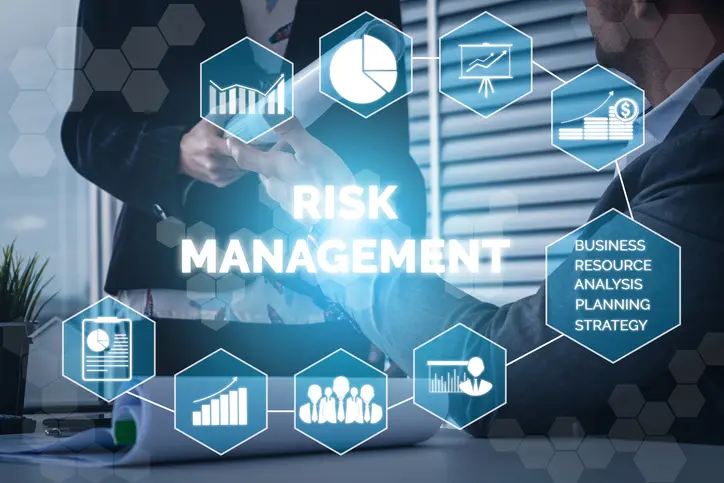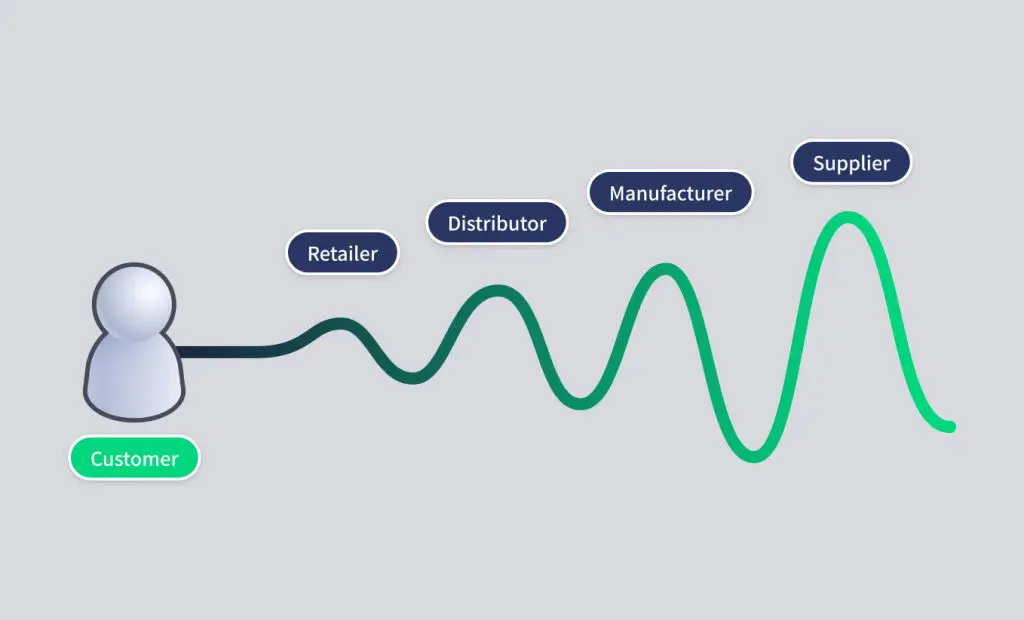The current business landscape is characterised by globalisation and interconnectedness, making supply chains increasingly complex and susceptible to various risks. Effective supply chain risk management is crucial for companies to prevent disruptions, reduce unexpected costs, and maintain their reputation. By proactively identifying, assessing, and mitigating potential risks, organisations can improve their resilience, ensure business continuity, and gain a competitive advantage.
Definition of Supply Chain Risk Management
Supply chain risk management (SCRM) is a systematic process of identifying, evaluating, and mitigating risks in the flow of goods, services, and information within supply chains. It integrates strategies, processes, and tools to minimise the impact of disruptions and ensure smooth operations. SCRM is crucial for companies across all sectors, as even minor disruptions can lead to significant consequences like production delays, financial losses, and reputational damage. Implementing robust risk management practices allows organisations to proactively address potential threats and develop contingency plans for unexpected events.
Types of Risks in the Supply Chain
The supply chain is a complex, interconnected system exposed to numerous risks from various sources. Managing these risks effectively demands a thorough understanding of them and their potential consequences.
Internal vs External Risks
Supply chain risks can arise from both internal and external factors, each posing significant challenges to an organisation. Internal risks are those within the company’s control and may include issues such as human errors in production or logistics, poor inventory management, and a lack of effective communication or coordination among departments. On the other hand, external risks are beyond the company’s direct influence and can include natural disasters like earthquakes or floods, political instability, cyberattacks, and disruptions caused by supplier bankruptcies or production failures. Both types of risks require careful management to ensure the resilience of the supply chain.
Operational Risks
Operational risks in the supply chain involve disruptions or failures in daily operations that can result from equipment malfunctions, human errors, quality control issues, or inefficient processes. These risks include machine breakdowns, labour strikes, transportation delays, quality control failures, and poor inventory management. Such operational risks can lead to significant consequences, including production stoppages, delivery delays, customer dissatisfaction, financial losses, and potential damage to a company’s reputation.
Financial Risks
Supply chains are vulnerable to financial risks that can greatly affect profitability and cash flow. Such risks consist of fluctuations in raw material prices, currency exchange rates, and unexpected increases in transportation or labour costs. Some examples of financial risks are volatility in commodity prices, currency fluctuations, rising transportation costs due to fuel price changes, and wage inflation. To mitigate these risks, companies can implement financial risk management strategies such as hedging, pricing adjustments, or diversifying suppliers to protect their bottom line
Geopolitical and Market Risks
Geopolitical and market risks encompass the challenges posed by political instability, trade tensions, regulatory changes, and market fluctuations, all of which can disrupt supply chain operations. These risks can lead to supply shortages, increased costs, and operational delays, impacting the seamless flow of goods, services, and information across borders. Examples include political unrest in key regions, shifts in trade policies or tariffs, changes in consumer demand, and economic downturns. To navigate these risks, organisations can monitor global developments, diversify their supply sources, and maintain robust contingency plans to adapt to changing conditions.
Risks Related to Sustainability and Climate
With rising concerns about sustainability and climate change, supply chains are increasingly pressured to adopt environmentally friendly practices and reduce their carbon footprint. Ignoring these risks can result in reputational damage, regulatory fines, or loss of market share. Key risks include stringent environmental regulations, climate-related disruptions, growing consumer demand for sustainable products, and pressure from stakeholders to embrace sustainable practices. Companies can address these challenges by implementing sustainable sourcing strategies, optimising transportation, investing in renewable energy, and promoting circularity and resource efficiency throughout their supply chains.
Risk Analysis in the Supply Chain
Successful supply chain risk management starts with a thorough analysis of potential risks. This approach involves identifying, evaluating, and continuously monitoring risks to create proactive mitigation strategies and strengthen overall resilience.
Identifying Risks: How to Recognise Them
The first step in effective supply chain risk management is to identify potential risks that could impact an organisation’s operations. This involves utilising various methods, such as supply chain mapping to visualise vulnerabilities, conducting regular risk assessments to evaluate threats at each stage, and leveraging data analytics to gain insights from historical data and market trends. Additionally, supplier audits can help uncover risks related to quality and compliance, while employee feedback can reveal operational concerns. Monitoring external factors, such as geopolitical developments and regulatory changes, also aids in anticipating risks. By combining these approaches, organisations can gain a comprehensive understanding of their supply chain risks and prioritise their risk management strategies effectively.
Risk Assessment: Methods to Evaluate Impact and Probability
After identifying potential risks, the next step in supply chain risk management is to assess their significance by evaluating their likelihood of occurrence and potential impact on the organisation’s operations, financial performance, and reputation. Various methods can be employed for this assessment, including risk matrices, which visually categorise risks by their likelihood and impact, and risk modelling, which uses statistical techniques to provide quantitative estimates. Failure Mode and Effects Analysis (FMEA) helps prioritise risks by identifying potential failure modes and their effects, while expert judgments offer qualitative insights from experienced professionals. Scenario analysis allows organisations to evaluate hypothetical situations and prepare contingency plans. By applying these methods, organisations can prioritise risks effectively and allocate resources to address the most critical threats.
Risk Monitoring: Tools and Technologies for Continuous Surveillance
Effective supply chain risk management necessitates continuous monitoring and surveillance to detect emerging risks and respond swiftly to potential disruptions. This can be achieved using various tools and technologies, such as advanced supply chain visibility solutions that offer real-time tracking, and risk intelligence platforms that analyse data from multiple sources using machine learning and natural language processing. Predictive analytics tools help forecast risks by identifying patterns in historical data, while IoT devices and sensors provide real-time monitoring of supply chain conditions. Additionally, supplier risk management systems enable organisations to track supplier performance and compliance. By utilising these technologies, organisations can maintain ongoing vigilance, quickly address emerging risks, and ensure operational continuity.
Risk Management in the Supply Chain
Successful supply chain risk management involves blending proactive and reactive strategies, utilising technology, and cultivating a resilient organisational culture.
Proactive vs Reactive Strategies
When managing supply chain risks, organisations can choose between proactive and reactive strategies, with their choice significantly influencing the effectiveness of risk management and overall supply chain resilience. Proactive strategies focus on anticipating and preparing for risks before they occur, aiming to minimise disruptions and ensure rapid recovery. This approach includes regular risk assessments, scenario planning, implementing redundancies, diversifying supply sources, investing in early warning systems, and developing strong partnerships with suppliers. By adopting proactive strategies, organisations can enhance their supply chain resilience, reduce the likelihood of disruptions, and mitigate the impact of risks when they arise.
Reactive strategies focus on responding to risks and disruptions as they occur, aiming to manage the immediate impact and restore normal operations. These strategies are necessary when risks are unexpected or unavoidable, but they can be more costly and time-consuming compared to proactive measures. Examples include implementing emergency response plans, expediting alternative sourcing, reallocating resources, and managing stakeholder communication. While reactive strategies are sometimes necessary, they should be complemented by proactive measures to enhance resilience. Ideally, organisations should adopt a balanced approach that combines both proactive and reactive strategies to effectively manage supply chain risks and ensure business continuity.
The Role of Technology and Innovation in Risk Management
Technology and innovation are essential for effective supply chain risk management, providing powerful tools to identify, assess, and mitigate risks. Advances in digital technologies, data analytics, and automation have transformed how organisations manage their supply chains. Key technologies include real-time supply chain visibility solutions using GPS, RFID, and IoT sensors; predictive analytics and AI for forecasting risks and recommending strategies; blockchain for enhancing transparency and trust; digital twins and simulations for testing scenarios; robotics and automation to address labour shortages and improve efficiency; and cloud computing for real-time data sharing and coordination. By leveraging these innovations, organisations can enhance their supply chain resilience, agility, and ability to navigate a complex business environment.
The Importance of Supplier Diversification
Supplier diversification is a vital strategy for mitigating supply chain risks and enhancing resilience by maintaining multiple suppliers for key components, raw materials, or services. This approach reduces dependency on a single source and minimises the impact of potential disruptions. The benefits of supplier diversification include reduced supply chain disruptions by allowing quick shifts to alternative sources, improved negotiating power through multiple options, mitigation of geopolitical and market risks by spreading suppliers across different regions, and access to innovative solutions from a broader range of suppliers. However, this strategy also brings challenges, such as increased complexity in managing multiple relationships, potential quality control issues, and the need for effective coordination. Organisations must carefully balance these factors and implement strong supplier management processes to maximise the benefits of diversification.
Creating a Corporate Culture Oriented Towards Resilience
Effective supply chain risk management goes beyond processes and technologies; it requires cultivating a corporate culture that prioritises resilience, preparedness, and continuous improvement. This involves strong leadership commitment to risk management, empowering and training employees to proactively address risks, fostering open communication and collaboration, and encouraging continuous learning from past experiences. Integrating risk considerations into decision-making and recognising employees who excel in risk management further reinforce this culture. By embracing these practices, organisations can enhance their ability to prepare for and respond to supply chain disruptions, safeguarding their operations and long-term success.
Risk Mitigation in the Supply Chain
While risk identification and assessment are crucial steps, effective risk mitigation is essential to minimise the impact of disruptions and maintain business continuity.
Business Continuity Planning: Preparation and Response to Contingencies
Business continuity planning (BCP) is essential for effective supply chain risk mitigation, ensuring that operations can be maintained or quickly resumed during disruptions. Developing effective BCP involves several key steps: conducting a comprehensive risk assessment to identify potential threats, performing a business impact analysis to prioritise critical functions, creating recovery strategies with clear objectives, documenting the plan with detailed procedures, regularly testing and updating the plan, and providing ongoing training for all stakeholders. A well-designed BCP enhances an organisation’s resilience, enabling it to minimise the impact of disruptions on operations, customers, stakeholders, and its reputation.
Collaboration and Strategic Partnerships as a Mitigation Tool
Collaboration and strategic partnerships are valuable tools for mitigating supply chain risks by fostering strong relationships and open communication with key partners. This approach enhances risk visibility, leverages collective resources, and facilitates joint strategies to address potential disruptions. Collaborative methods include information sharing, joint contingency planning, conducting collaborative risk assessments, pooling resources, and participating in industry associations. Effective partnerships require trust, open communication, and a shared commitment to resilience, with organisations selecting partners based on their risk management capabilities and alignment with their own strategies and values.
Using Predictive Analysis Tools and Artificial Intelligence
Predictive analysis tools and artificial intelligence (AI) are increasingly used in supply chain risk management to improve risk identification, assessment, and mitigation. These technologies process vast data, identify patterns, and provide actionable insights for proactive management. Key applications include AI-powered demand forecasting for better inventory management, supplier risk monitoring using predictive analytics and natural language processing, predictive maintenance through machine learning and IoT sensors, AI-driven risk scenario modelling, intelligent routing and logistics optimisation, and anomaly detection in supply chain data. Effective implementation of these technologies requires high-quality data, strong data governance, and skilled personnel to act on the insights generated.
Effective Strategies for Addressing Supply Chain Risk
Integrating Risk Management
Integrating supply chain risk management into an organisation’s overall business strategy is essential for ensuring long-term resilience and success. Rather than being treated as a separate or reactive function, risk management should be embedded in core decision-making processes and aligned with strategic objectives. This integration involves conducting strategic risk assessments, incorporating risk considerations into strategic planning, ensuring risk-informed decision-making, aligning risk appetite with strategy, fostering cross-functional collaboration, and continuously monitoring and adapting risk management efforts. By doing so, organisations can make more informed decisions, effectively allocate resources, and proactively manage risks to support long-term growth and competitiveness.
Effective Inventory Management at your fingertips? Learn more below.
Best Practices for Global Risk Management
As supply chains become more globalised, organisations must adopt best practices to manage risks across multiple regions and countries. Effective global risk management involves addressing challenges such as geopolitical tensions, cultural differences, regulatory complexities, and supply chain vulnerabilities. Key practices include establishing a comprehensive global risk management framework, conducting localised risk assessments to consider regional factors, fostering cross-cultural collaboration, leveraging local expertise, and implementing robust compliance programs. Additionally, diversifying the supply base, developing contingency plans, utilising technology and data analytics, fostering organisational agility, and collaborating with industry partners and governments are essential. By adopting these practices, organisations can effectively manage global risks, ensure supply chain resilience, and maintain a competitive edge in a volatile global business environment.
Case Studies on Companies that have Successfully Implemented Risk Mitigation Strategies
These case studies highlight how companies have successfully implemented supply chain risk mitigation strategies to enhance resilience:
- Apple Inc.: Apple employs a multi-pronged risk management strategy, including supplier diversification, rigorous auditing, and proactive risk monitoring. By diversifying its supplier base, conducting regular audits, and leveraging predictive analytics, Apple has maintained a resilient supply chain, minimised disruptions, and upheld ethical practices.
- Cisco Systems: Cisco focuses on supply chain visibility, collaboration, and business continuity planning. By implementing advanced visibility tools, collaborating closely with suppliers, and developing robust continuity plans, Cisco has navigated challenges like natural disasters and the COVID-19 pandemic with minimal operational impact.
- General Motors (GM): GM adopts a comprehensive risk management approach, emphasising supplier risk assessment, contingency planning, and risk-based decision-making. Through rigorous supplier assessments and strategic planning, GM has effectively managed disruptions like the global semiconductor shortage, reducing financial and operational impacts.
- Unilever: Unilever’s strategy centres on sustainable sourcing, supplier collaboration, and fostering a risk-aware culture. By focusing on sustainable practices and close supplier collaboration, Unilever has managed risks related to climate change and resource scarcity, while maintaining sustainability goals and a strong brand reputation.
These examples demonstrate that effective supply chain risk mitigation requires tailored, proactive strategies, the use of technology, collaboration, and a culture of risk awareness, enabling companies to navigate the complexities of modern supply chains successfully.
Understanding the Importance of Supply Chain Risk Management
In the contemporary, interconnected business environment, supply chain risk management is vital for organisational resilience and long-term success. As supply chains become more complex and exposed to various risks, companies must adopt advanced methodologies to proactively identify, assess, and mitigate potential disruptions. Effective risk management involves a comprehensive approach, utilising technologies like predictive analytics, AI, and supply chain visibility tools to gain insights and respond swiftly to threats. Collaboration with suppliers, partners, and industry associations enhances risk visibility and fosters coordinated mitigation strategies. Integrating risk management into overall business strategy ensures that organisations align their efforts with strategic objectives and make informed decisions. Ultimately, supply chain risk management is a strategic imperative that not only minimises disruptions and costs but also provides a competitive advantage, ensuring business continuity and sustainable growth in a volatile global market.
Mitigate risk with Intuendi and prepare for whatever comes next.






